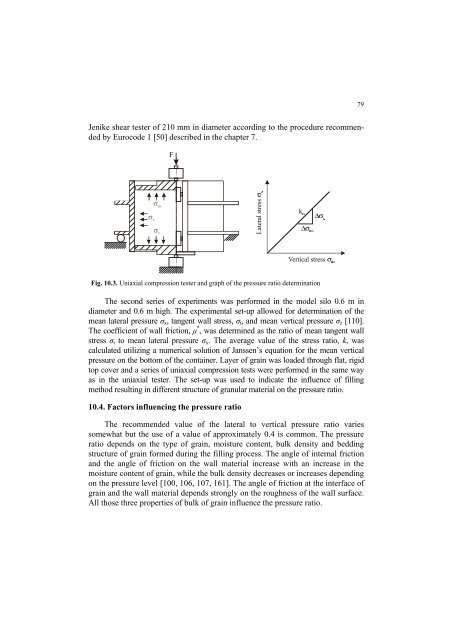Strona 2_redak - Instytut Agrofizyki im. Bohdana DobrzaÅskiego ...
Strona 2_redak - Instytut Agrofizyki im. Bohdana DobrzaÅskiego ...
Strona 2_redak - Instytut Agrofizyki im. Bohdana DobrzaÅskiego ...
You also want an ePaper? Increase the reach of your titles
YUMPU automatically turns print PDFs into web optimized ePapers that Google loves.
79<br />
Jenike shear tester of 210 mm in diameter according to the procedure recommended<br />
by Eurocode 1 [50] described in the chapter 7.<br />
)<br />
/DWHUDOVWUHVVσ[<br />
NVR<br />
∆σ]P<br />
∆σ[<br />
9HUWLFDOVWUHVVσ]P<br />
Fig. 10.3. Uniaxial compression tester and graph of the pressure ratio determination<br />
The second series of exper<strong>im</strong>ents was performed in the model silo 0.6 m in<br />
diameter and 0.6 m high. The exper<strong>im</strong>ental set-up allowed for determination of the<br />
mean lateral pressure 1 x , tangent wall stress, 1 t , and mean vertical pressure 1 z [110].<br />
The coefficient of wall friction, * , was determined as the ratio of mean tangent wall<br />
stress 1 t to mean lateral pressure 1 x . The average value of the stress ratio, k, was<br />
calculated utilizing a numerical solution of Janssen’s equation for the mean vertical<br />
pressure on the bottom of the container. Layer of grain was loaded through flat, rigid<br />
top cover and a series of uniaxial compression tests were performed in the same way<br />
as in the uniaxial tester. The set-up was used to indicate the influence of filling<br />
method resulting in different structure of granular material on the pressure ratio.<br />
10.4. Factors influencing the pressure ratio<br />
The recommended value of the lateral to vertical pressure ratio varies<br />
somewhat but the use of a value of approx<strong>im</strong>ately 0.4 is common. The pressure<br />
ratio depends on the type of grain, moisture content, bulk density and bedding<br />
structure of grain formed during the filling process. The angle of internal friction<br />
and the angle of friction on the wall material increase with an increase in the<br />
moisture content of grain, while the bulk density decreases or increases depending<br />
on the pressure level [100, 106, 107, 161]. The angle of friction at the interface of<br />
grain and the wall material depends strongly on the roughness of the wall surface.<br />
All those three properties of bulk of grain influence the pressure ratio.
















